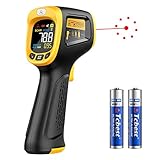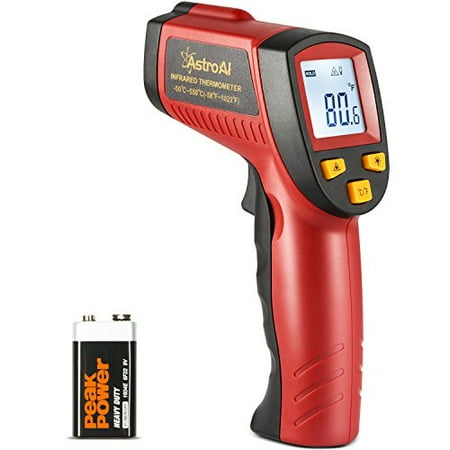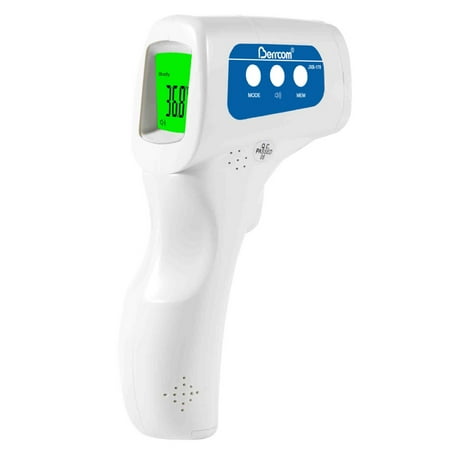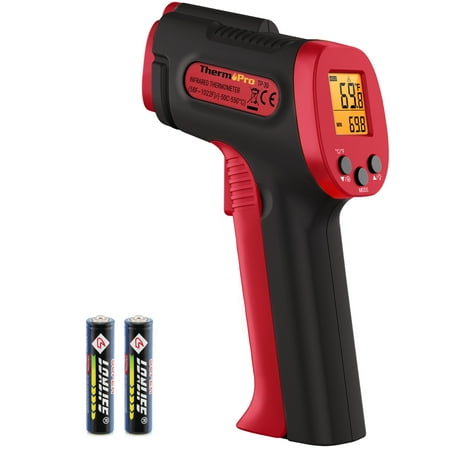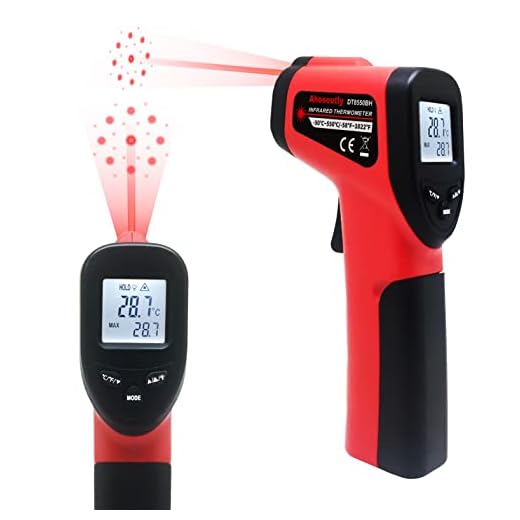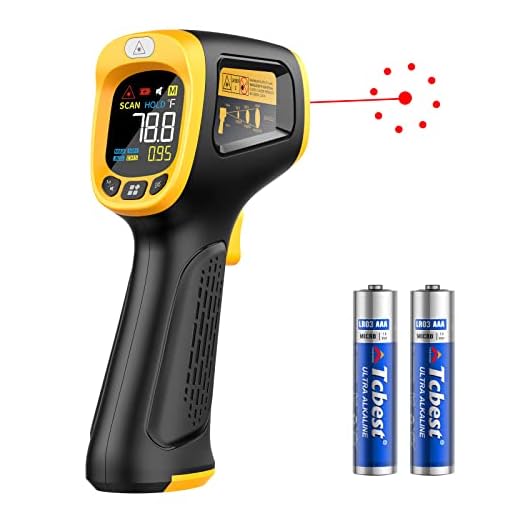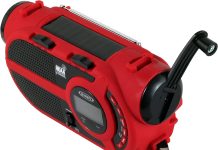Have you ever wondered how infrared thermometers work? Have you looked at one and thought, “How on earth does that thing measure the temperature of something without even touching it?”
Well, if so, then you’ve come to the right place. This article will discuss precisely how infrared thermometers work and what makes them valuable tools for measuring temperatures from afar.
Infrared thermometers are special devices that use infrared radiation emitted by an object to calculate its surface temperature.
They do not require physical contact with the objects they measure – making them incredibly convenient tools in many industries. This technology is used in laboratories and everyday life; whether you’re looking to check food safety or monitor engine performance, IR thermometers can be invaluable.
By understanding how they work, we can appreciate why infrared thermometers have become essential in many applications today.
So let’s take a closer look at these fascinating instruments! We’ll dive into the science behind their inner workings and explain why they do accurate readings even when there isn’t any direct contact between the device and the measured object.
Review contents
Overview Infrared Thermometers
Infrared thermometers are a type of temperature measurement device. They use infrared technology to capture heat radiation to measure the surface temperature of an object.
The infrared thermometer works by emitting a beam of light, which is invisible to the human eye, and then measuring how much energy is reflected from the object’s surface. This information is used to determine its temperature.
This type of thermometer can be used without direct contact with objects, making it ideal for situations where physical contact would not be possible or desirable.
It also provides accurate results as temperatures can be measured quickly and up to several meters from the measured object.
Definition
Infrared thermometers are temperature measurement devices that use thermal radiation, or heat transfer, to measure the surface temperature of an object.
These thermometers use a sensor to detect infrared light emitted from the object and convert it into an electrical signal.
This signal is then processed by an onboard processor, which determines the temperature based on black body radiation calculations.
Black body radiation is a physical phenomenon where all objects with temperatures above absolute zero emit energy through electromagnetic waves, known as thermal radiation. Infrared thermometers measure this thermal radiation to determine an object’s temperature.
By detecting these wavelengths and accurately processing them, infrared thermometers can provide accurate readings for any given target quickly and easily.
This understanding of how infrared thermometers work provides insight into the physics of light and heat, giving us a better understanding of our environment and allowing us to monitor changing conditions more effectively.
Physics Of Light And Heat
Infrared thermometers measure the thermal energy emitted by objects to determine their temperature. They do this by detecting infrared radiation, a light wave with a wavelength too long for humans to see with the naked eye.
Thermal energy is converted into electrical signals and then sent to a display device like LCD or LED screen where temperatures are read in Celsius and Fahrenheit. This heat transfer happens through conduction and can be detected far away with an infrared thermometer.
The essential part of any infrared thermometer is its optical system. It includes lenses, filters, and detectors that collect and analyze the thermal radiation detected from the measured object.
The lens focuses the incoming radiation onto the detector while the filter helps isolate wavelengths within specific ranges so only desired targets are picked up as readings.
With these components working harmoniously together, accurate results can be obtained quickly and efficiently for safe use in industrial settings or everyday life.
Types Of Thermometers
Infrared thermometers are just one type of temperature-measuring device.
There are several types, such as digital thermometers, which measure the temperature via an electrical current; non-contact thermometers, whicthatnot require contact with the object being measured in otoe readings; and thermocouple thermometers which use two metal probes connected to measure temperatures accurately.
Thermistors are also used for measuring temperature and rely on changes in resistance.
All these different types have their advantages and disadvantages when taking accurate measurements.
Each can be used depending on the required measurement, so understanding each type is essential for ensuring reliable results. With this knowledge, we can now explore the advantages of infrared thermometers.
Advantages Of Infrared Thermometers
Infrared thermometers offer numerous advantages compared to traditional thermometers. One of the main benefits is they can take temperature readings without making contact with the object or subject being measured, which makes them particularly useful in medical settings.
Not only are infrared thermometers more hygienic and less intrusive than traditional thermometers, but they also provide quicker and more accurate results when measuring body temperatures. This allows healthcare professionals to identify potential illnesses earlier while minimizing cross-contamination risk.
Additionally, these devices have improved energy efficiency since most infrared thermometers require minimal power consumption for operation. Furthermore, many models come equipped with unique features such as LED display screens that make it easier for users to read temperature measurements from a distance.
Thus, infrared thermometers get you more reliable data faster and safer than other thermometers, but they’re also cost-effective and easy to operate.
Overall, infrared thermometers are incredibly valuable for their accuracy, ease of use, health benefits, and energy efficiency. Transitioning into how these tools work in terms of technology requires understanding how light waves interact with physical objects…
How They Work
Moving from the advantages of infrared thermometers, let’s look at how they work. Infrared thermometers measure heat by detecting the light and heat emitted by an object or surface without contact.
They contain a lens focusing on an object to collect its infrared radiation and convert it into an electronic signal. Depending on the model used, this signal is displayed as temperature readings in Celsius or Fahrenheit.
Here are four critical points about how these thermometers work:
- An infrared thermometer uses light instead of physical contact to determine the temperature
- It measures the thermal radiation of objects using light waves (infrared)
- The accuracy and precision of the thermometer depend on proper calibration
- Factors such as ambient temperature can affect the accuracy of measurements
As we move forward, let’s consider some essential accuracy considerations when using infrared thermometers. Knowing how these devices operate allows you to make more informed decisions when measuring temperatures accurately.
Additionally, understanding their components helps to maintain their performance over time with regular maintenance and calibrations needed for peak accuracy.
Accuracy Considerations
Infrared thermometers are highly accurate, but there are accuracy considerations to keep in mind. Accuracy measurement is usually expressed as a temperature uncertainty or deviation.
Temperature accuracy depends on factors such as the emissivity of the object being measured and the distance between the object and the sensor head. An infrared thermometer should be calibrated regularly to maintain its accuracy over time.
When measuring temperatures with an infrared thermometer, it’s essential to consider any environmental conditions that could affect the result, such as wind speed and direction, background radiation from other sources, or even changes in air pressure.
Choosing an appropriate optical resolution for your application can minimize the effects of these variables. This will help ensure you get an accurate reading regardless of external influences.
Taking these precautions when using an infrared thermometer ensures maximum accuracy for all your temperature measurements.
Applications
Infrared thermometers are used in various industries, from food temperature monitoring to automotive temperature measurement.
They’re also used for medical diagnostics and fever detection. Industrial temperature monitoring often utilizes infrared thermometer technology due to its ability to measure temperatures without contact.
This eliminates the need for physical probes or sensors that can disrupt production lines. It’s also helpful in food safety processes, as it measures internal surface temperatures accurately and quickly.
Infrared thermometers offer an easy way to measure accurate temperatures across many different industries safely and reliably. In the medical field, infrared thermometers help doctors detect fevers quickly and effectively by measuring skin temperature from the forehead or ear canal.
Automotive technicians use these devices to ensure parts function correctly and don’t overheat during operation.
Safe Use
When discussing the applications of infrared thermometers, it’s important to remember that safe use is critical. Non-contact temperature measurement devices require careful handling and proper calibration practices to ensure user safety.
Infrared radiation emitted from these thermometers should never be directed toward someone’s eyes, which can cause injury. To prevent any potential harm or misreading of temperatures, users must take extra care when using non-contact thermometers.
Furthermore, users should pay attention to instructions provided by the manufacturer regarding their device usage.
This includes keeping the measuring distance constant while reading, avoiding contact with moisture and dust, and understanding how environmental factors such as wind speed and ambient temperature affect readings taken with infrared thermometers.
By following all necessary precautions, users will gain reliable results for accurate temperature measurements. Moving forward into discussing calibration practices for further accuracy…
Calibration Practices
Calibrating an infrared thermometer is essential for accurate readings. It ensures the accuracy of the device and that it meets industry standards.
Generally, calibration involves checking and adjusting a thermometer to ensure accuracy against accepted reference points or sources.
For instance, a standard blackbody calibrator can be used to check the accuracy of an infrared thermometer over its entire range. The blackbody also provides a known temperature source for making adjustments when necessary.
To maintain consistent results, many organizations follow strict calibration procedures and schedule regular checks to their quality control requirements.
Cleaning practices are also crucial for the proper function of an infrared thermometer, as dust and other debris may affect performance if left on the optics lens surface.
Cleaning Requirements
It’s essential to adhere to the cleaning requirements for infrared thermometers. Cleaning supplies, such as cotton swabs and alcohol-based solutions, are necessary for maintaining a hygienic device.
Additionally, it’s essential to follow the manufacturer’s cleaning protocols and instructions, which may recommend specific cleaning processes or solutions. To ensure the accuracy of readings, users should clean their thermometers regularly with approved cleaners.
Doing so will extend the life of the device and prevent cross-contamination between patients if used in medical settings. After ensuring that all surfaces have been adequately cleaned, proceed with battery care.
AstroAI Digital Infrared Thermometer 550, Laser Temperature Gun with LCD Screen -58℉~1022℉ (-50℃~550℃), Baking, Barbecue, Car Engine and Tire, Red, for Gifts
KIZEN Infrared Thermometer Gun (LaserPro LP300) - NOT for Humans
LPOW Forehead Digital Thermometer,The Non-Contact Infrared Thermometer for Babies,Kids&Adults,1s Fast Reading with 3 Colors Backlight Fever Alarm and 50 Memories Recall
$14.99 in stock
HiTouch Business Services Non-Contact Infrared Thermometer (JXB-178) JXB178
$7.88 in stock
ThermoPro TP30W Digital Infrared Thermometer Gun Non Contact Laser Temperature Gun -58°F ~1022°F (-50°C ~ 550°C) with Adjustable Emissivity & Max Measure (NOT for Human Body Temperature)
$19.99 in stock
Battery Care
Caring for your battery is essential to ensure it lasts a long time. Proper battery maintenance ensures that you get the most out of your device and allows you to avoid costly replacements. Here are some tips on how to extend the life of your battery:
First, make sure you charge your battery correctly. Overcharging or undercharging can damage the cells inside the battery and reduce its lifespan significantly. Also, pay attention to how often you use your device; overuse can cause premature degradation.
It would be best to avoid leaving your device plugged in too long when charging, as this could lead to overheating and harm the internal components. Lastly, consider purchasing an external charger so you don’t have to worry about constantly replacing batteries throughout the year.
These small steps will go a long way toward keeping your device running smoothly for many years. Maintenance tips such as these will help ensure that all parts of your device stay in working condition for extended periods, saving you money and frustration.
Maintenance Tips
It’s essential to stay on top of maintenance for your infrared thermometer to keep it working correctly. There are several practices that you can use to ensure the accuracy and longevity of your device. First, be sure to calibrate your thermometer according to manufacturer instructions regularly.
This is especially important if you have used the thermometer in environments with varying temperatures or humidity levels. Additionally, follow proper cleaning protocols outlined by the product manual – this usually includes wiping down the lens after each use.
Finally, inspecting all components for signs of wear and tear, such as loose screws or frayed wiring, is also a good idea. Contact customer service or take the device to a professional repair shop for further assessment if anything looks amiss.
With these simple maintenance tips in mind, you can rest assured that your infrared thermometer will remain accurate and reliable. Now onto troubleshooting tips…
Troubleshooting Tips
Troubleshooting tips for infrared thermometers can help to identify and resolve common problems quickly. If the device displays an error code, several solution methods are available.
Firstly, check the battery connections; if they are loose or corroded, replace them with new ones. Secondly, ensure all settings on the device are correctly adjusted based on the instructions in the user manual. Finally, inspect any wiring connected to the unit and replace it if necessary.
Taking a proactive approach towards maintaining your infrared thermometer will go a long way in keeping it functioning correctly over time. Although identifying and fixing errors from home can be difficult, following these tips should allow you to resolve the most common issues with minimal assistance.
If these steps do not fix the problem, you may need to contact a diagnostics specialist further to troubleshoot your infrared thermometer.
Single next focus on alternatives to infrared thermometers to explore other options when dealing with malfunctioning devices.
Alternatives To Infrared Thermometers
Now that we have discussed troubleshooting tips for infrared thermometers, let’s look at available alternatives.
There are several options for temperature measurement beyond using an infrared thermometer.
Contactless thermometers, also known as non-contact thermometers, are famous for measuring body temperature without touching the patient.
These devices use thermal imaging technology and do not require physical contact with the person being measured.
Additionally, there is a wide range of other temperature measurement tools, such as digital ear thermometers and oral thermometers which can be used instead of an infrared thermometer.
Overall, these alternative methods should provide valuable solutions if you’re looking for another way to measure temperatures accurately without using an infrared thermometer.
Frequently Asked Questions
What Is The Difference Between Infrared And Contact Thermometers?
Infrared and contact thermometers measure temperature, but how do they differ? Infrared thermometers use infrared radiation to detect the temperature of an object without making physical contact.
On the other hand, contact thermometers require direct physical contact with the measured item to read its temperature.
Contact thermometers work by having a probe inserted into or placed on the surface of an object. The device then reads heat energy emitted from the object and displays it as a numerical value on a digital display. In comparison, infrared thermometers don’t require any direct physical contact; instead, they measure thermal radiation emanating from objects at distances up to several feet away.
This type of thermometer collects infrared light waves radiated off an object’s surface and converts them into electrical signals for measuring temperature.
It is important to note that this method can only be used for non-living materials such as metal and stone since living things like humans will give inaccurate readings due to their body temperatures being lower than the environment temperatures around them.
These two types of thermometers provide different benefits depending on their application, so it’s essential to understand how each one works before selecting one for your needs.
Contact thermometers are ideal for measuring small items accurately, while infrared ones offer more convenience when reading large surfaces or those at a distance.
What Is The Maximum Temperature That An Infrared Thermometer Can Measure?
Infrared thermometers are capable of measuring temperatures from -50°C to 550°C (-58°F to 1022°F). This wide range of temperature measurements allows them to be used in various applications, such as medical facilities, automotive plants, and industrial processes where high-temperature accuracy is required.
Generally speaking, the higher the temperature capability of an infrared thermometer, the more expensive it will be. The highest temperature limits for these devices typically fall between 950°C and 1050°C (1742°F and 1922°F).
However, some models may offer lower or higher ranges depending on their intended use. Generally speaking, most consumer-grade models have a limit of 500°C (932°F), while professional-grade ones can reach up to 1100 °C (2012 °F).
Infrared thermometers are designed specifically for non-contact measurements and allow users to accurately measure surface temperatures without physically contacting them. They are also suitable for remote monitoring and measuring applications over long distances because they can quickly capture accurate readings at varying distances.
Furthermore, they require minimal calibration and no additional accessories, making them even more versatile than other thermometers.
How Often Should An Infrared Thermometer Be Calibrated?
Calibrating an infrared thermometer regularly can help maintain its accuracy and provide reliable readings. It is essential to understand the calibration frequency for an infrared thermometer to ensure accuracy.
Several factors should be considered when determining how often a device should be calibrated, including the environment it is used in, any changes made to the settings or hardware, and usage intensity.
Below are three aspects of infrared thermometer maintenance that need to be taken into account:
- Infrared Thermometer Calibration: The frequency at which an infrared thermometer needs to be calibrated depends on its intended use and overall condition. It should typically be done every six months or sooner if necessary. During this process, users must follow the manufacturer’s instructions to calibrate it correctly and accurately.
- Frequency of Calibration: Depending on usage conditions and requirements, calibration may need to be more frequent than the manufacturer initially recommended. Infrared thermometers should also be checked after major repairs or adjustments.
- Calibration Procedure: A qualified technician will usually perform the calibration procedure following established standards based on industry guidelines or regulations set forth by governing bodies such as NIST (National Institute of Standards & Technology). This ensures that all measurements obtained using the instrument are accurate and precise.
In addition to ensuring proper operation of your infrared thermometer, regular calibration helps you identify potential issues with your device before they become too severe and costly to repair.
Proper maintenance also helps prevent inaccurate readings from being reported due to outdated or malfunctioning parts within the device.
Does An Infrared Thermometer Require A Warm-Up Time Before Use?
One of the most commonly asked questions regarding infrared thermometers is whether or not they require a warm-up time before use.
The answer is yes; an infrared thermometer needs a warm-up time before taking a measurement. This is because, during the warm-up period, the sensor in the thermometer warms up and calibrates itself to ensure that accurate readings are taken each time.
The amount of pre-use warm-up required for an infrared thermometer varies depending on the model and environmental factors such as temperature and humidity. Generally speaking, a good rule of thumb is to allow at least 15 minutes for the device to reach optimal operating temperatures — but this can be longer if necessary.
During this period, keeping other heat sources away from the thermometer is essential so external elements don’t affect its reading.
A set warm-up procedure is essential if you want consistent, reliable results with your infrared thermometer. It may take some trial and error initially.
Still, once you know how long your model needs to adjust correctly, you’ll have no problem getting precise measurements every single time.
What Is The Battery Life Of An Infrared Thermometer?
Regarding infrared thermometers, battery life is an essential factor to consider. Many thermal infrared thermometers have a battery life expectancy of up to 6 months with typical daily use.
However, this can vary depending on the model and how often it’s used. In addition, some models require more frequent battery replacements due to their power requirements or if they’re used for extended periods.
Knowing about your specific device’s battery life will help you plan when purchasing replacement batteries or deciding whether an extra set would be beneficial in terms of convenience. Depending on the design and type of infrared thermometer, the battery duration may range from 8 hours up to several weeks before needing to be replaced.
It’s essential to refer to the manufacturer’s information regarding the recommended type of batteries and any other relevant details related to their overall performance, such as calibration frequency, warm-up times, and response rates.
Additionally, considering cost and availability is essential when selecting new batteries for your infrared thermometer.
Considering all these aspects – including battery life – you can ensure that your chosen device meets your needs while providing accurate readings over long periods without replacing batteries too frequently.
Conclusion
In conclusion, infrared thermometers are a convenient and accurate way to measure temperature.
They are simple to use and require no contact with the measured object. Infrared thermometers can measure temperatures up to 500°C, depending on the model, which is usually higher than contact thermometers.
It’s essential to calibrate your infrared thermometer regularly for greater accuracy. Additionally, many models do not need any warm-up time before use; however, some may have longer battery lives if given this opportunity.
An infrared thermometer is an excellent tool for measuring temperature quickly and accurately without directly contacting the measured object.
Etekcity Infrared Thermometer 1080, Heat Temperature Temp Gun for Cooking, Laser IR Surface Tool for Pizza Oven, Meat, Griddle, Grill, HVAC, Engine, Accessories, -58°F to 1130°F, Yellow
Etekcity Infrared Thermometer Upgrade 774, Heat Temperature Temp Gun for Cooking, Laser IR Surface Tool for Pizza, Griddle, Grill, HVAC, Engine, Accessories, -58°F to 842°F, Yellow
Klein Tools IR1 Infrared Thermometer, Digital Laser Gun is Non-Contact Thermometer with a Temperature Range -4 to 752-Degree Fahrenheit
7 used from $28.95
Infrared Thermometer Temperature Gun (NOT for Humans) -58℉~1022℉ (-50℃~550℃) 9-Point Laser Non-Contact Instant-Read Digital Laser Infrared Ir Thermometer with Backlight
KIZEN Infrared Thermometer Gun (LaserPro LP300) - Handheld Heat Temperature Gun for Cooking, Pizza Oven, Grill & Engine - Laser Surface Temp Reader -58F to 1112F - NOT for Humans
$19.75 in stock
Infrared Thermometer Non-Contact Digital Laser Temperature Gun Color Display -58℉~1112℉(-50℃~600℃) Adjustable Emissivity - for Cooking/BBQ/Food/Fridge/Pizza Oven/Engine - Meat Thermometer Included
Infrared Thermometer Gun -58°F ~932°F, Digital Laser Thermometer Gun for Cooking, Pizza Oven, Grill, IR Thermometer Temp Gun
Eventek Infrared Thermometer Gun, -58°F~1022°F (-50°C~550°C) Digital Laser Temperature Gun for Cooking, Pizza Oven, Grill, Engine, IR Thermometer Temp Gun with Adjustable Emissivity & Max Min
$11.99 in stock








